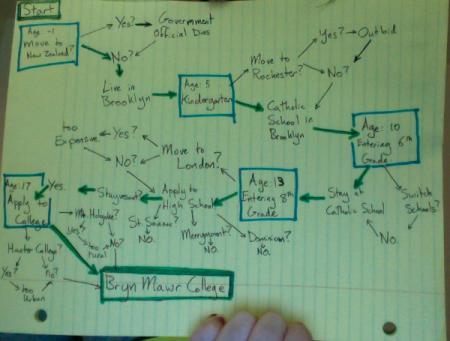Serendip is an independent site partnering with faculty at multiple colleges and universities around the world. Happy exploring!

Posting Part 2/3: My Flesh and Blood
My Flesh and Blood
2003 UR 84 minutes
Winner of both the Audience and Directing Awards at the 2003 Sundance Film Festival, this inspiring documentary tracks a year in the life of Susan Tom, a single parent from suburban Fairfield, Calif., who has adopted 11 children with special needs. Directed by Jonathan Karsh, the film obliterates stereotypes about people with disabilities, sharing joyful moments and everyday challenges without shying away from the family's heartbreaking losses.
http://movies.netflix.com/WiMovie/My_Flesh_and_Blood/60032556?trkid=2361637
My Flesh and Blood is available on Netflix instant watch

Posting Part 1/3: Southern Comfort
Southern Comfort
2001 NR 90 minutes
This moving documentary chronicles the last year in the life of Robert Eads, a female-to-male transsexual dying of ovarian cancer. We're introduced to several prominent figures in Robert's life -- most importantly, his life partner, Lola Cola. Lola is a transsexual who's become Robert's life partner and caretaker. The two prepare to lead a panel at the annual Southern Comfort conference, a yearly event created for transgendered individuals.
http://movies.netflix.com/WiMovie/Southern_Comfort/60026998?trkid=2361637
Southern Comfort is available for delivery via Netflix.

perception and titles of the "disabled"
I have never studied disability before. Never mulled over the intersections of disability and gender. I found both Fiona Shaw and Eli Clare's sections on freakdom palpable. They seemed to emphasize the cultural rather than (perhaps less constructed) need we have to stare. Theresa Tensuan provided a quote by Rosmarie Garland-Thompson that explains staring in more forgiving, understanding terms, as "an ocular response to what we don’t expect to see…. when ordinary seeing fails, when we want to know more...Staring begins as an impulse that curiosity can carry forward into engagement."
For activists, maybe. Maybe we stare in order to understand, to normalize. But culture has a funny way of impairing pure eyesight. Because we already know what's normal, right? We already have a notion of the bell curve of physicality and what's outside of it. In Eli Clare's chapter on freaks, he understands it as a mode of strengthening and fortifying a person's notions of self/other, "normal and abnormal, superior and inferior." But he paints a complicated picture, layer upon layer of exploitation and status quo reinforcement, with the realities of the historical time period. Was it still exploitation if the freaks used their 'taken-for-granted' inferiority to dupe the circus-goers out of money, getting moderately rich in the process?Is it right for "freaks" to perpetuate a negative societal stereotype about their own bodies? And is empowerment through such a process possible?
Week 2: Clare and Stigma
For another one of my classes, we have been reading Erving Goffman's Stigma, and thus it was through the lens of a constructed personal/social identity, as well as the management of that identity, that I read Exile and Pride. Through personal anecdote as well as historical contextualization, Clare explores what the terms "freak", "queer", "supercrip", "retard", "dyke" mean - he explores what these words denotate, conotate, and how they are utilized social context. Within this exploration of identitity - both personal and social, "insider" and "outsider" constructions of it - Clare analyzes both positve and negative constructions of each lexical term and how they represent the individuals standing behind them. Through such analysis Clare expresses how some of these terms may be used to stigmatize on the one hand, or to express pride on the other. However, Clare does not idealize the elevation and adulation of the "disabled" or the "queer" for overcoming and persevering. Instead Clere idealizes the notion of difference without the assignment of value. In short, he asks for the erradication of such stigma. Confronted with this ideal, I would ask: how as a society do we come to normalize things such as disability and gender (not conforming to the male/female binary)? What would it take realistically to enact such a change in social perception?
Living The Good Lie
In our discussion of Mimi Swartz’s “Living the Good Lie,” we talked about what resulted in, for these men, the inability for the coexistence of homosexuality and devotion to religion. Judith Glassgold, the chair of a taskforce on LGBT issues from the American Psychological Association, stated in an interview for the article, “Among therapists — both among gay activists and the religious — we can have a discussion. We all agree that arousal and orientation are not under someone’s volition. What we can work on is self-acceptance, integration identity and reducing stigma.” I continued to think about whether homosexuality and religion are necessarily mutually exclusive, or rather if there are ways in which the two can coexist within an individuals’ identity. I kept thinking back to interviews that I’ve conducted with scholars in Argentina regarding their passage of same-sex marriage legislation. One of them, Daniel Jones, explained to me that evangelicals weren’t ubiquitously opposed to the bill. I found a paper he recently wrote where he lays out some of the tactics used by various evangelical groups to approach homosexuality. One strategy in particular stood out to me; the Evangelical Church of the Río de la Plata published a document in 2000 stating that the sexual orientation of a person is fixed and predetermined; homosexuality is a concept from the nineteenth century that, as a word, never appears in the original words of the Bible.






